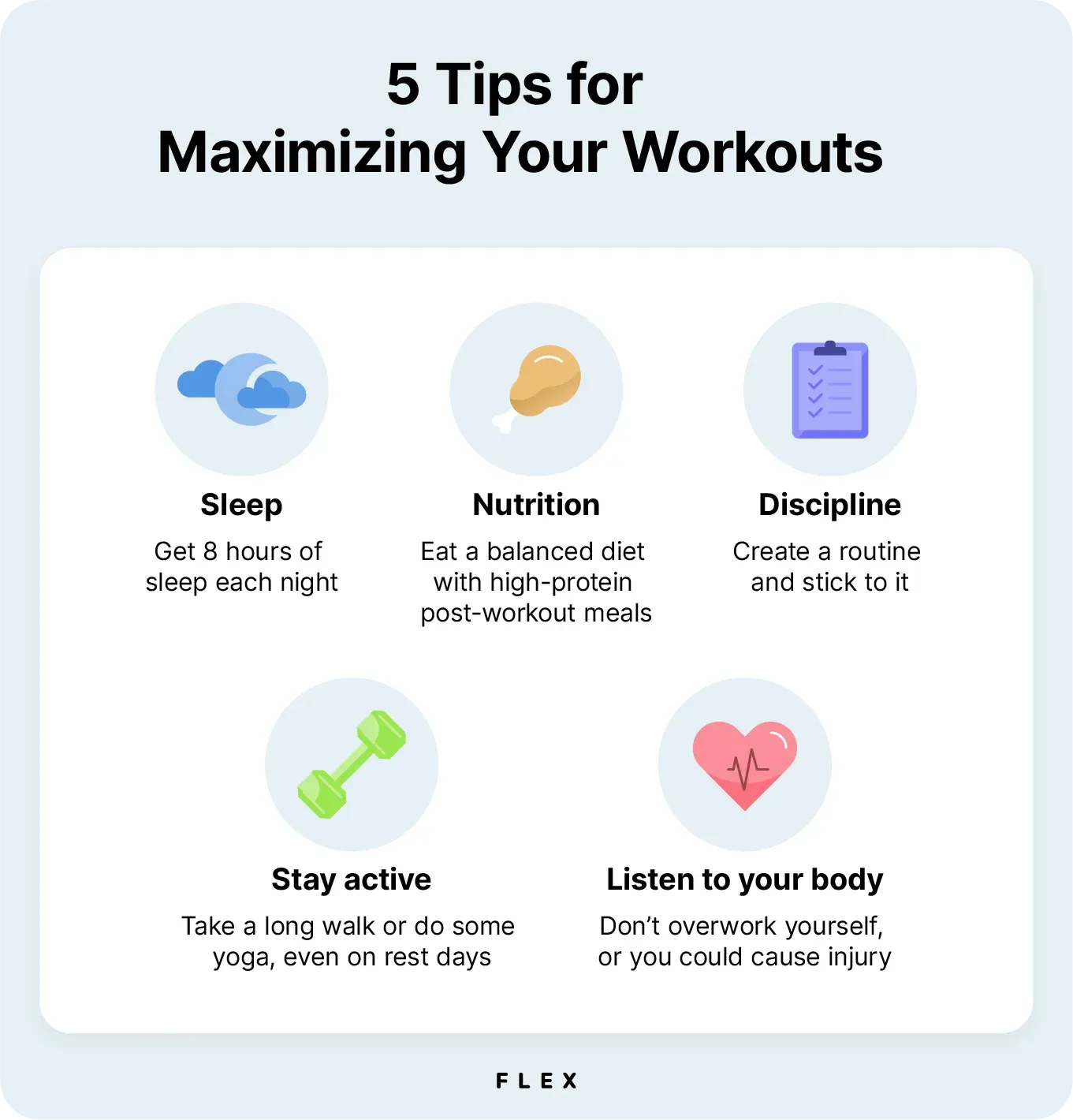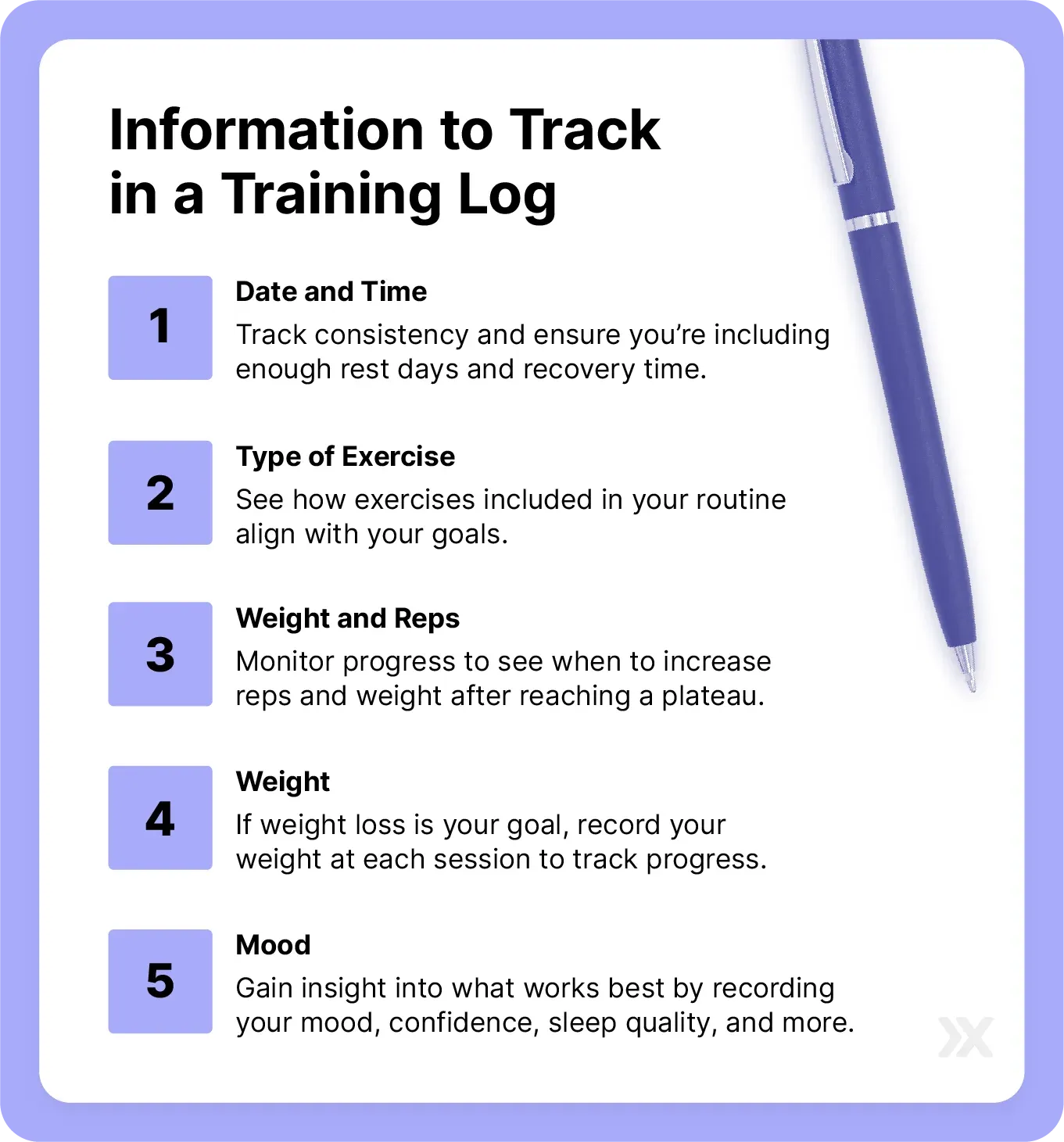How Often Should You Go to the Gym to Hit Your Fitness Goals?
You should go to the gym three to five times a week, depending on your individual goals. Read on to find out how to schedule your workouts, what exercises to include, and when to take rest days.
Finding time to exercise is difficult for many people starting their fitness journeys, but once you get in the groove, how often should you go to the gym?
The answer to this question depends on your individual goals and fitness level. More gym time does not necessarily equal faster results. We consulted experts to find the ideal workout frequency for three popular goals: losing weight, building muscle, and maintaining overall physical health.
How Many Days per Week Should You Workout?
The number of days per week you should work out depends on your own personal goals.
“Fitness is not one-size-fits-all,” says orthopedic surgeon Myroslav Dosiak. The ideal gym schedule for someone training for a marathon is going to look very different compared to someone recovering from an injury and trying to regain their flexibility.
So, how many times a week should you go to the gym, based on your personal goals? Here’s a general guide:
- Weight loss: 3 to 4 times a week
- Building muscle: 4 to 5 times a week
- Maintaining good health: 2 to 3 times a week
Goal: Lose Weight
For weight loss, go to the gym three or four times a week. Focus on high-intensity cardio with rest days in between. According to Healthline, cardio burns more calories than weightlifting. Throw in some resistance training, like plank exercises, to add variety to your workout and build lean muscle.
Beginners can start with low-impact activities like walking or swimming, while more advanced fitness enthusiasts can customize their own high-intensity interval training (HIIT) and kettlebell workouts. Remember: Consistency is key!
Recommended workouts:
- Beginner: HIIT Treadmill Workout for Beginners
- Intermediate: Best Weighted Ab Exercises for a Toned Core
Goal: Build Muscle
Want to build muscle? To see results, hit the gym four to five times a week with progressive strength training and compound exercises.
Beginners can start with bodyweight exercises like wall push-ups three times a week and work their way up to weights and machines. Advanced lifters might prefer a split workout routine that focuses on different muscle groups on different days.
Recommended workouts:
- Beginner: Beginner Kettlebell Arm Workout
- Intermediate: 3-Day Workout Split, PHUL Workout
- Expert: Greek God Workout, Rich Piana Arm Workout
Goal: Maintain Physical Health
To maintain your overall physical health, aim for two to three gym sessions a week. Focus on full-body workouts with elements of cardio and strength training.
Aerobic activities like walking, cycling, or swimming are great for beginners who want to focus on maintaining cardiovascular health. As you progress, you can move on to a three-day-a-week full-body workout.
Don’t forget to include a warm-up stretching routine before your workout to increase flexibility, improve mobility, and prevent injury.
Recommended workouts:
- Beginner: Compound Core Exercises, Lower Trap Exercises to Improve Posture
- Intermediate: 3-Day Full Body Workout Routine
How Long Should You Be at the Gym?
Around 45 to 90 minutes is the optimal amount of time to spend in the gym, with the sweet spot being one hour.
Again, this answer will depend on your fitness level, goals, and the types of workouts you’re doing. Let’s break down a typical hour at the gym based on the scenarios we covered above:
- To lose weight, flip it: 45 minutes of moderate to high-intensity cardio plus 15 minutes of strength training.
- To build muscle, flip it: 15 minutes of light to moderate cardio as a warm-up followed by 45 minutes of strength training.
- To maintain physical health, it’s an even split: 30 minutes of cardio and 30 minutes of strength training.

Official guidelines from the U.S. Department of Health and Human Services state that adults should engage in the following:
- Moderate intensity physical activity: A minimum of two and a half hours and a maximum of five hours each week
- Vigorous aerobic activity: A minimum of an hour and fifteen minutes and a maximum of two and a half hours each week
A blend of both is also acceptable.
What's an Effective Workout Routine?
The most effective workout routine is one that is customized for your specific fitness goals, but one thing’s for certain: Rest days are important if you want to see any progress.
“A split routine — chest and triceps one day, back and biceps another — gives each muscle group 48 to 72 hours of recovery time to optimize hypertrophy and strength gains,” says Michael Betts, physical therapist and director at TRAINFITNESS.
For muscle building, Dosial recommends compound exercises and progressive strength training focusing on major muscle groups five times a week, plus a warm-up routine of stretches to maintain mobility.
If weight loss is your goal, hit the gym three to four times a week with a focus on cardio and a bit of strength training. To tone your core, try incorporating Russian twists and windshield wiper workouts.
For overall well-being, look for ways to include yoga or aerobic activities like swimming, biking, or walking with your loved ones.

Tips for Maximizing Your Workouts
The hours you spend outside the gym are equally important as those you spend inside it. An overall healthy lifestyle keeps your endurance up so you can crush your goals.
- Prioritize sleep: According to a study of over 10,000 Chinese university students in the Journal of Musculoskeletal & Neuronal Interactions, poor sleep is associated with an increased risk of losing muscle mass. Sleep is essential for muscle growth and repair, so try to get a solid eight hours per night.
- Focus on nutrition: Diet is just as important as exercise, so fuel your body with healthy foods. Eat high-protein meals after a workout to encourage muscle repair. “Match your calorie and macronutrient intake to your goals. For weight loss, ensure a moderate calorie deficit, and for muscle gain, aim for a slight surplus with sufficient protein,” says Adam Kemp, professional basketball player and ISSA-certified personal trainer.
- Stay disciplined: Once you're at the gym, make it count. Follow a high-quality workout routine and minimize distractions.
- Keep it moving: Rest days don’t have to be couch potato days. Try some light yoga or brisk walking to stay active while you recover.
- Listen to your body: Don’t overwork yourself, or you’ll pay the price. Always stop a workout if you’re feeling too sore or fatigued. Pushing yourself too hard could result in an injury that keeps you out of the gym for weeks or even months.
Should You Go to the Gym Every Day?
The short answer is no, you should not go to the gym every day. Rest days are essential for letting muscles grow and rebuild. Plus, for many people, going to the gym daily just isn’t realistic.
“Striking the right balance is essential. Recovery isn’t just time away from the gym; it’s when the body repairs and adapts, making rest days, sleep, and proper nutrition as crucial as the workouts themselves,” says Kemp. “Your fitness routine should be sustainable and adaptable to your goals, helping to create a foundation for long-term health and wellness.”
Remember to slow down. Take time to focus on building healthy habits that carry over into your life outside the gym.
Risks of Overtraining
Working out can improve your health, but overtraining has its risks, including:
- Irritability and mood swings
- Soreness and fatigue
- Hormonal imbalances
- Lowered immunity
- Serious injur
“Skipping rest days raises the risk of tendonitis by 30%,” Dosiak cautions.
If you’re feeling the burn a little too much, limit your high-intensity sessions to two or three times a week and closely monitor your fatigue levels. Never feel guilty for giving your body the rest it needs.
“A training log is really helpful for tracking frequency and recovery. Write down your workouts and how you feel, and you’ll be able to see patterns and adjust frequency,” suggests Betts.
Whether you call it a gym diary, an exercise tracker, or a training log, it’s a good idea to write down your progress somewhere. If you wear a smartwatch, you can easily note your heart rate, calories burned, hours of sleep, and workout duration.

Workout Frequency FAQ
When you’re shaping your workout routine, questions are bound to arise. Flex Fitness has the answers you need.
Should You Go to the Gym Twice a Day?
Beware: Going to the gym twice in one day is a fast track to burnout, not the results you’re looking for. Such a schedule is typically only suitable for professional athletes. Instead, focus on staying consistent in other areas of your life, like eating nutritious meals and getting enough sleep. This will help your body recover and avoid muscle fatigue.
Is Three Times a Week Enough Gym Time?
Yes, exercising three times a week is an ideal gym frequency, especially for beginners. This cadence ensures you get enough rest in between your workouts as your body adjusts.
Is Working Out 6 Days a Week Too Much?
For most people, yes. Going to the gym six days a week can quickly lead to burnout, throwing you off course for your fitness goals. For more advanced bodybuilders, a 6-Day Gym Workout Schedule might be appropriate.
What Are the Benefits of Going to the Gym Regularly?
Working out isn’t just about improving your physical fitness. According to Johns Hopkins Medicine, routine exercise regulates your sleep cycle and releases endorphins, leading to better mental health and decreased stress.
How Often Should You Go to the Gym To Be Healthy?
Going to the gym three to five times per week is a good goal, but the real answer to this question will vary from person to person. Everyone has their own individual fitness level, lifestyle, and goals. Aim to create a routine that's sustainable, fits in with your schedule, and supports your long-term well-being.
Can Going to the Gym Too Often Lead to Negative Results?
Yes, overworking yourself can lead to injuries that keep you out of the gym. To avoid serious setbacks like these, always listen to your body and stop when you feel too sore or tired.
Hit Your Fitness Goals with Flex Fitness
Once you’ve determined how often you should go to the gym, it’s time to create an exercise plan and follow through.
Sticking to a weekly workout plan is easier with Flex Fitness. Our all-in-one platform helps you make progress no matter where you are in your journey. Download the free Flex AI app to help track your workouts and stay committed to your fitness goals.
References
Yanbo Chen, Yufei Cui, Shulei Chen, Ziqiang Wu. Relationship between sleep and muscle strength among Chinese university students: a cross-sectional study. National Library of Medicine. https://pmc.ncbi.nlm.nih.gov/articles/PMC5749041/
Related articles


Get fit with Flex
Build muscle & lose weight fast for free.
Available on iPhone + Apple Watch





